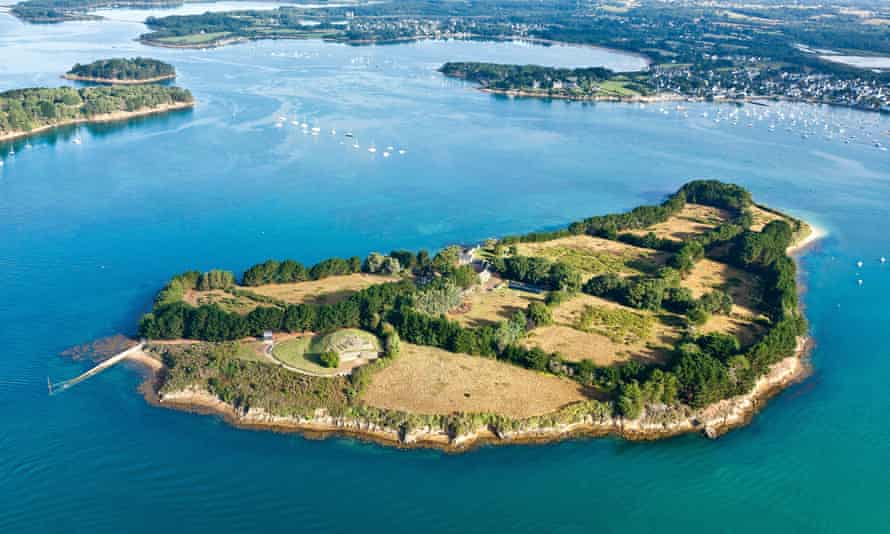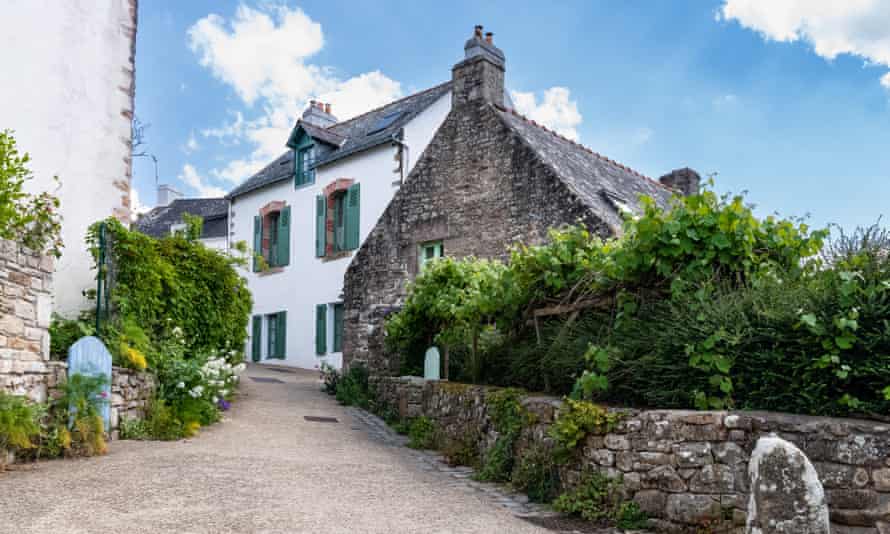I‘m in a dark corridor with four strangers. The ceiling is low, as is the temperature, and the granite walls are covered in engravings: overlapping patterns of wavy lines and psychedelic swirls, like giant notepad doodles etched in stone. We stumble slowly along the passage, peering at the carvings by torchlight. It feels a bit like being in an art gallery during a power cut – except here, the gallery in question is a 6,000-year-old burial chamber on an uninhabited island.
“This is the Cairn de Gavrinis,” says my guide, Maude, as I emerge blinking into the French afternoon. “We call it the neolithic Sistine Chapel. It’s empty now, but we think it held the most important members of local stone age society.” I’ve come to the Gulf of Morbihan, a natural harbor speckled with more than 30 green islands on Brittany’s south coast, but I’ve been beaten to it by some six millennia. The cairn’s builders, and its original occupants, were here in an era so distant that the islands here weren’t islands at all, but low hills separated by rivers.
The megalithic legacy left by these settlers, in the form of dolmens, stone circles and this richly decorated burial chamber – which sits at the heart of a mansion-sized cairn – is one of the bay’s chief attractions. But there are other good reasons to visit this relatively little-known corner of north-west France. If mention of the Brittany coastline throws up images of windblown cliffs and ferry ports, the Gulf of Morbihan turns such lazy generalizations on its head. Looking out from the mainland on my first morning, I’m greeted by a scene that seems to belong to another place entirely, with pink camellias and shaggy vegetation fringing a calm, glassy inlet.
The gulf is no blink-and-you’ll-miss-it backwater. About 30 miles east of the seaport of Lorient, it’s more than 12 miles long and runs north-south for about seven miles. It opens into the Bay of Biscay, but is almost entirely enclosed by two long headlands, giving the gulf and its sleepy islands the feel of somewhere hidden from the wiles and waves of the ocean.

I’m here to sample a new four-night walking itinerary offered by KE Adventure, an operator that made his name running trips to the Himalayas. This break is intentionally a far tamer affair, with an emphasis on slow days and quiet coastal paths: less K2 and crampons, more coffee and croissants. I’ve traveled here by train, initially by Eurostar to Paris, then on a two-and-half-hour ride to Vannes, the capital of Morbihan, a journey which seems in keeping with the whole no-rush experience.
My base is the family-run Parc Fetan hotel (swimming pool at the back, gooey brie de Meaux on the breakfast buffet), in the small mainland commune of Larmor-Baden. It’s a likable waterside village with bay views, a few seafood restaurants and a boulangerie that does fantastic baguettes, but only seems to open when you’re looking the other way.
The hiking, too, is laid-back. My first full day is taken up with a gentle nine-mile wander along the shore, following a meandering, needle-strewn path that largely sticks to GR34, one of France’s official national trails. Giant cypresses and maritime pines arch overhead, while the gulf itself has an almost lake-like quality, with the odd fishing boat the only sign of life. Islands slumber off the beaches, low-slung and tree-cloaked.

The walk is a combination of the familiar and the more exotic. The surface underfoot is laced with knobbly roots and scattered with pinecones. White-tailed bumblebees bump around beds of sea campions. Long-tailed tits jitter among the cypress boughs. Grebes dive offshore, robins hop across the path, and at one point – thrillingly – two hoopoes swoop overhead. I pass well-tended houses and a striped Breton flag flapping from a garden pole. When the sun comes out, the warmth is quiet and cosseting.
There’s more of the same the next day. The bay has a handful of tidal islands – accessible by foot, but only at certain times. One, the plurally named Sept Îles, is part of the first day’s walk, while another, Berder, is factored in today. The time table says it can be reached at 13.11; I brave the 100 meter crossing at 12.56 and arrive with wet socks. The island just two miles round, appears to be entirely uninhabited – although there is a locked chapel with morose gargoyles. Its trees are tall, bluebells grow in the grass, and the water in its coves is cold and clear. “Berder is a jewel – a jewel,” I’d been told that morning at the hotel. “It’s all about seeing life slowly.” And the visit is a precursor to my late-afternoon boat trip to Gavrinis, where it’s all about the prehistory.

The gulf would make a fine short-break destination in its own right, thanks to the twin appeal of delicate light and ancient remains. The larger islands are all reachable by foot or boat – longer bay cruises are also available – and the concentration of megaliths (and accommodation) around the little town of Locmariaquer, on the gulf’s western shore is a further draw.
Even as a walking holiday, this is a break more focused on pottering and putting than clocking up the kilometers. There are terraces to linger on, which qualifies me to recommend Brasserie Kerblei for local beer, and Cidrerie du Golfe for cider, enjoyed with Emmental-stuffed galettes. In terms of the hiking itself, however, the itinerary leaves the best until last, with a day trip to the largest island in the bay, Île-aux-Moines.

The full shoreline walk measures around 24km, though you can improvise by wandering the single-track lanes that thread around the island. Some 600 lucky souls live out here. Egrets step into the shallows; horse chestnuts tower over the paths. I stick mainly to the shaded, gorse-laden shore, but venture inland to reach the spectacular neolithic tomb Dolmen de Penhap, which I have to myself. Drizzle comes in, so I shelter on a wall under a thick blackthorn. Somehow I nod off, and when I wake up the rain has gone and the whole harbor seems to zing with freshness.
Folk have been drawn to this part of the French coast since at least 4,000 BC. Were their stone-carved swirls and zigzags some sort of tribute to the shifting watery landscapes they saw around them? We’ll never know. But to come here today still carries a lesson for the ages: that taking your time on a walk can be mighty enjoyable.
The trip was provided by KE Adventurewhose new five-day Self-Guided Walking on Brittany’s South Coast runs until September 30 and cost from £510pp. The price includes accommodation, breakfastfull route notes, oyster and wine tastingg, and boat journeys. The trip starts and finishes in Larmor-Baden. Travel was provided by eurostar,which has faresfr om London St Pancras International to Paris Gare du Nord desde £39. Trains to Vannes from Paris Montparnasse cost from £45 one way.
www.theguardian.com
George is Digismak’s reported cum editor with 13 years of experience in Journalism